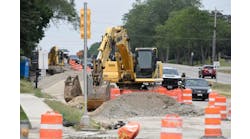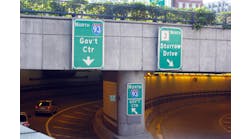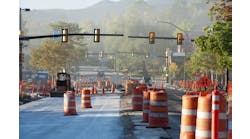It is not always easy to approach a giant. The Woodrow Wilson Bridge project, which overlaps the mighty Potomac River and connects Virginia and Maryland, has certainly eased any tension between the road portion and the oversized signature span. The round, curved approaches that filter traffic in and out of the crossing also are leaving their mark.
Complex challenges followed up with complimentary solutions is why the roads portion of this job was named No. 4 on the Roads & Bridges 2008 Top 10 Roads list—eight years after the bridge portion was named to the inaugural Top 10 Bridges list.
The Rte. 1 and Telegraph Road interchanges are indeed the signature pieces of the road construction. However, before equipment was oiled up for work there was concern about the strength of the soil at both sites. To add more bulk crews have executed a number of measures.
At the Rte. 1 interchange about 9,000 soil-cement columns have been mixed in-place; lightweight geofoam, which weigh in at just 2 lb per cu ft, has been installed; a lightweight low-density cementitious fill material, weighing 30 lb per cu ft, has been used; and a lightweight So-Lite Aggregate, 70 lb per cu ft, has been laid. Pile-supported embankments and prefabricated vertical drains also have been installed. Densified-aggregate piers have been used at the Telegraph Road interchange, along with compaction grouting.
Officials hope the site also will be injected with life in the years to come. There are four wetland sites around the Rte. 1 interchange, including a tidal emergent wetland located underneath the interchange ramps along Cameron Run.
At Telegraph Road crews will construct a 2-acre wetland that will include forested sections, scrub shrub wetland and tidal emergent zones. In addition, there are two wetlands constructed on each side of the George Washington Memorial Parkway.
“Tidal emergent wetlands are common along the Potomac River in this area,” the Woodrow Wilson Bridge Project told Roads & Bridges in an e-mail. “The planning and construction of our mitigation sites mimic what is found naturally.”
Overall, the program created or preserved over 100 acres of wetlands in the area, and construction of tidal wetlands was a major component of the project’s $55 million environmental mitigation program.
When all is constructed in early 2009, Rte. 1 will provide congestion relief to 115,000 motorists daily.
Another key component to the project is the widening of the Capital Beltway past the Telegraph Road interchange.


